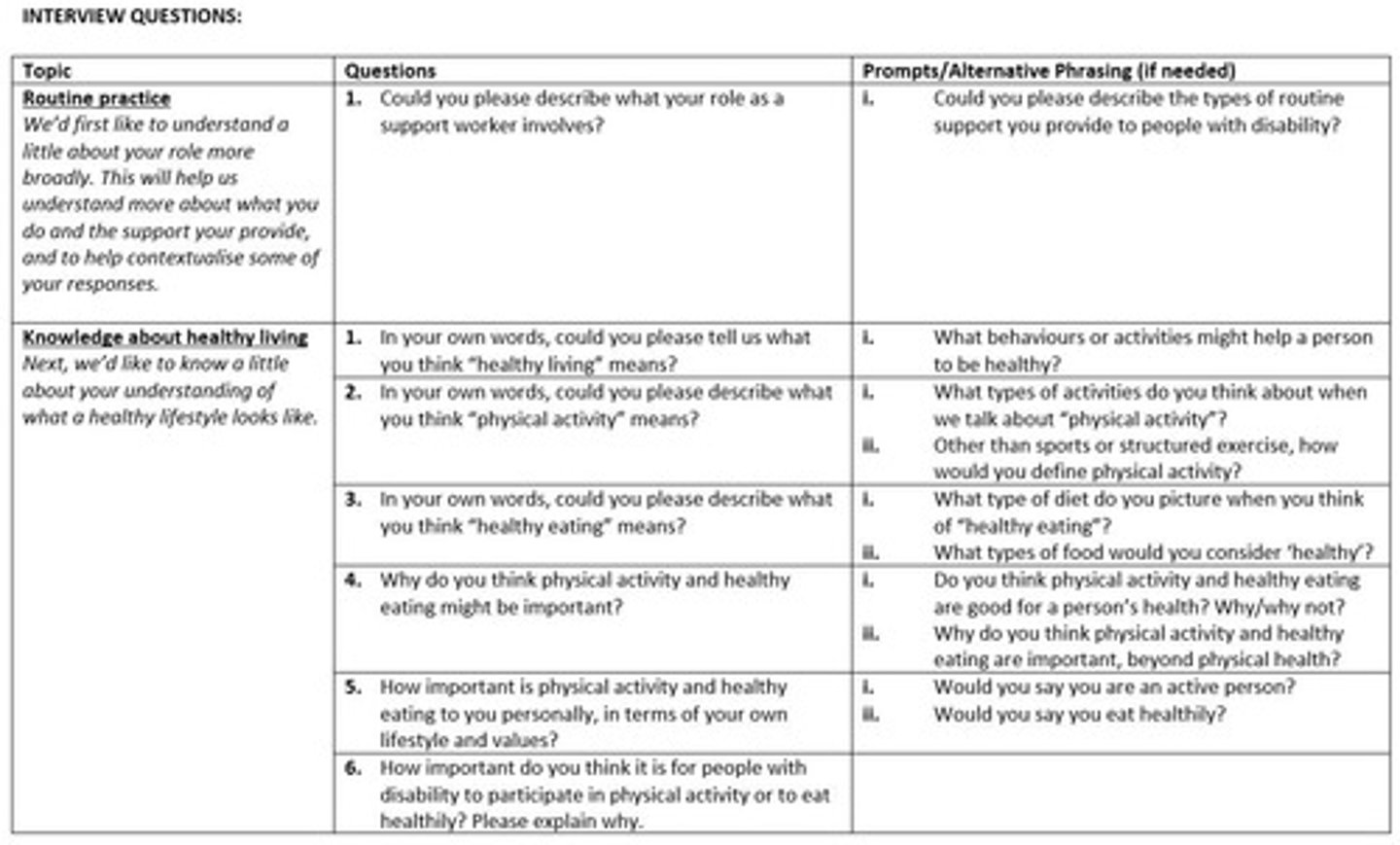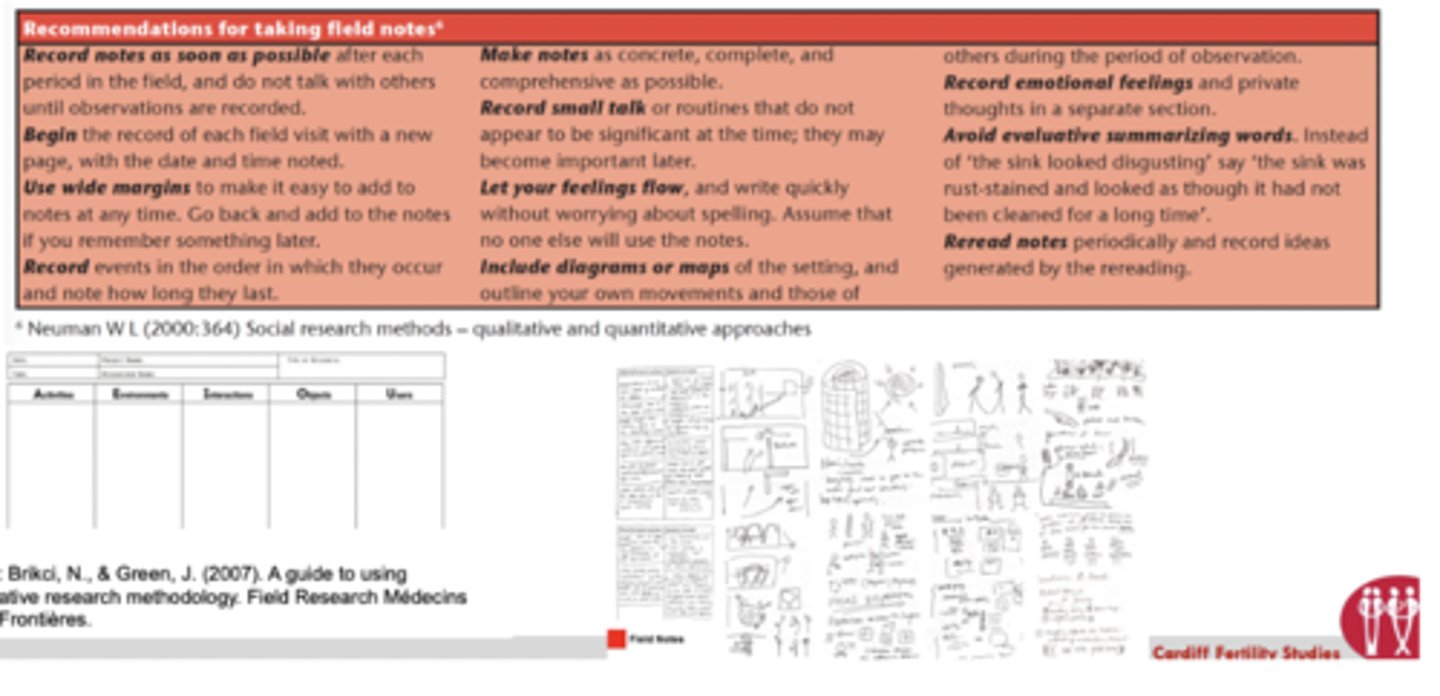human behaviour 2 (qual data collection)
1/31
There's no tags or description
Looks like no tags are added yet.
Name | Mastery | Learn | Test | Matching | Spaced |
|---|
No study sessions yet.
32 Terms
¨Methods to generate qualitative data
¤ Individual interviews
¤Group interviews/discussions (focus roups)
¤Non-interactive data collection (textual data from qualitative survey, diaries, media content, narrated stories using images)
qualitative data is in the form of
words rather than numbers
Individual interviews
¨Like everyday conversations between researcher and interviewee
¤Focused on researchers need for data (not like therapy focused on patients need)
¤Conducted to ensure trustworthiness of data (reliability & validity)
how individual interviews are Conducted to ensure trustworthiness of data
Reproducible: Someone else with same topic guide can generate similar findings (all have diff interviewing syles but with same q + population should get si iliar findigs, can prerodce)
Systematic: No cherry-picking participants or observations from the interview
Credible: Reasonable design (questions and methods) to yield truthful accounts
Transparent: Method used reported and accessible to others, so all know how data was generated
key features of interviews

place of interveiw
-interview setting also very important
Shoudl be professional but not too clinical
-should not feel like interrogation okay to be a bit cosy
why Building and maintaining rapport important
¨Interviewees need to trust interviewer
Interviewer interested in them and what they have to say
Interviewer will not judge interviewee for their answers
how to Building and maintaining rapport
¨Interviewer should set the interview context
Introduce yourself and give your name, aims of interview, reminder that interview can stop at any time and possibility of asking any questions; be sensitive to needs of interviewees (e.g., hard of hearing, frail, embarrassed, literacy level for topic) ¨
Keep in mind effects of interviewer personal characteristics (ethnicity, status, gender, social distance, clothing)
what is a visual metaphor
-visual metaphors uses smth visible (monster, situation) too show something invisible (thought/feeling)
If your fertility was an object, what would it be? - clock on back
top tips for interviewing
People interviewed often in vulnerable state
• Do not create expectations you cannot fulfil
• Tell the person what you plan to do with the information and then do it
things to bear in mind while interviewing
-rules for interaction differ across cultures eg are eye contact, sitting positions, certain non-verbal noises, silences appropriate
-dont agree/disagree
-check understanding - dont rely on assumptions, patients might not use medical terminology in the same way
things to aovid while interviweing
-dstractions/interruptions from others
-questions that are embarrassing, leading, have multiple ideas or are too rapid (likely to remain superficial ) , jump from one topic to another too quickly
-teaching, counselling or giving your own perspective
Semi-structured [open-ended] interviews
- topic guide comprises open-ended questions for a defined area of interest (e.g., quality of life and arthritis)
¨In-depth qualitative or unstructured interviews
-Very broad open-ended questions
'-Tell me about your experiences of arthritis'
-Goal is to elicit information as is relevant to the interviewee quality of life may or may not be a topic interviewee brings up
topic guides
-can enhance reproducibility
Used mostly in semi-structured interviews
¤Key questions interviewer would like to cover
¤Useful prompts to elicit discussion of topics if specific issues do not come up ¨
How to formulate questions?
¤Must be as non-judgmental as possible
¤Avoid leading informant to particular answers

endometriosis example problematic questions and why
1. How many symptoms do you have? Too specific for first question; does not allow broadening out (normally do more of a funnel and want open qs)
2. What issues have adhesions caused? Jargon [adhesions] Please describe how endometriosis has affected you
3. How is your sex life? Timing of sensitive questions - maybe contextualise more genra about relatonship - some wiill bring it up can probe
4. Why so long to come into clinic? Ask neutral questions
5. What can the clinic do for you? Avoid being too broad. Is this question about medical care or other support? About staff or the clinic itself? About desired services or existing services
6. When did you first start having symptoms? Out of place in sequence. No prompts to support recall - e.g., link to puberty
endometriosis better more open questions
1. Tell me about your symptoms [of what you now know is endometriosis]?
2. How has endometriosis affected you're your life? a. Your relationship with your partner b. Your sexual life? 3. Why did you decide to come to the clinic at this time?
4. What support services at the clinic could help? a. How would you feel (do you feel) about services to manage relationship/sexual life impacts
5. Anything else you would like to add about impacts of endometriosis on your relationship?
questions should
-start general get more sensitive towards end
-what level language to use to be understood - but dont use technical words
-open, neutral, concrete ef(reating to specific examples)
if questions are not generating useful data can try
-diary questionn (describe day in life)
-critical incidents - worst/best experience
-free listing - eg causes of malraia
-ranking (items generated by free listing)
Group discussions (focus groups)
-Ease of disclosure in groups
Expressing dissatisfaction with healthcare
Sensitive topics that all group members share eg PCOS
-Group processes can help people to explore and clarify their views in ways that would be less easily accessible in a one-to-one interview
-Groups give access to how people talk to each other about topic
Informative about social structure (context, fabric) of the community and how opinion
-Informs how knowledge is formed in social contexts (behaviour in action)
May not be appropriate for marginalised or vulnerable group members
-people tend to minimise symtpoms hen talking to doctors
Characteristics of group interviews
¨Discussion with a group of people (formal, informal) ¨
Formal (focus group, natural group)
Natural groups are interested in group norms;
Focus groups in a range of views
natural group - ai
Natural groups are pre-existing groups used mainly in ethnographic or social research. They often involve informal discussions, with data collected through observation or notes. In contrast, focus groups are formed specifically for research, with selected participants discussing a topic in a controlled setting. These sessions are usually recorded and guided by a moderator, making them useful for testing materials, exploring opinions, or evaluating programs.
focus groups
-ppts selected to meet criteria
-seeks discussion of target toic
-more formal + controlled
-normally audio taped / transcribed
¨Participant recruitment
-Best is to have people willing to discuss and this is determined by:
Rapport (as discussed)
Awareness, understanding, interest and perceived gain from discussing research topic X
Compatibility in social structure (e.g., power, influence, etc - people vaary sensitive to these when taling about social life)
-6 to 10 people for sustainable discussion; over recruit 25% for attrition
-Ask for volunteers, or help of gate-keepers (tribal leaders, directors)
-Natural groups depend on access to them (just obsrving - consent form different)
Running a group (in brief)
¨Capable moderator(s)
Number of groups will depend on expected saturation
Saturation = when additional data collection no longer generates new understanding ¨
Select appropriate setting ¨
Use tape/Zoom/Teams recorders (for full transcripts)/ dedicated note taker ¨
Use appropriate topic guide ¨
Start group with icebreaker (get to know/general qyestion)
Discussion starter to set initial positions ("How is treatment planned at your clinic?") ¨
Final summary statement from each member to signal the approaching end of the group
¨Capable moderator(s)
[usually 2 for leading discussion & operations]
provide a clear explanation of the purpose of the group (e.g., duration, topic)
help people feel at ease (consider how awkward when no one knows
facilitate interaction between group members using topic guide ¨
Challenges in focus group interviews
- Balance between homogeneity (similar) and heterogeneity
(dissimilar)
- Viewpoints too extreme (anti-vaxer Vs virologist)
- Social divisions too great (Company CEO vs shop floor assistant)
- Dominance of one voice (Loudest, most informed or confident)
- Participant interested in topic but not personally invested- No motivation to engage fully
- Group context makes it easier to not engage
-Also consider money - people join then mute for money ethically should pay them, also effect other ppts , need t consder
quantitative data example fertility
-rate strongly disagree to s agree for reasons they have not convcieve
-analyse reasons and gender differences
-eg something they have done
-then ask to describe - this can be analysed qualitatively
Quantitative and qualitative survey data
-can have both analyse separately then bring together
Qualitative Analysis of previous study
-quotaions (from descriptions of what they'd done) to codes to themes to broad themes
-for men the two broad themese were sexuality and risk
Observations and field notes
-sometimes not just words but mood of the room is important
-people have different ways of doing this eg drawings

Other sources of contextual data
¨Reports of previous research (e.g., from literature search)
¨Country reports about phenomena
¨Clinic and service records
¨Policy reports (e.g., national, international, NGOs, WHO)
¨Oral data ¤Informal conversations
Conclusions and re-cap
¨Different strategies to collect qualitative data, which is data expressed in the form of words rather than numbers ¨
Data collection approach must ensure "trustworthiness" of data
¨Individual and group interviews (focus groups) have pros and cons; which is best depends on research goals ¨Non-interactive methods are also possible, especially now with online open surveys ¨
Contextual data is also collected to help in interpretation process